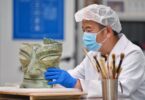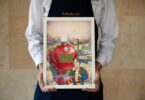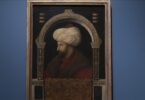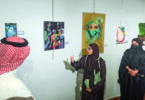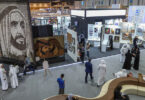LONDON (Arabnews): “I would love to be a poet. I pursue poetry through color.” Sudanese artist Rashid Diab is talking to Arab News about the inspiration behind his work.
That inspiration is perhaps clearest in his three-part series “Homage to My Poet Friend,” dedicated to the late poet and diplomat Salah Ahmed Ibrahim.
“I found in his poems what I was looking to do in my paintings — specifically in a very long poem about the migration of the birds from the South to the North,” Diab explains. In that poem Ibrahim urged the birds to keep flying and let nothing stand in their way: “If one of your wings happens to wane, just speed off/To where? Until you see the Nile studded with images of the stars/Like a sword embroidered with jewels scattered in disorder,” Ibrahim wrote.
“The most important thing about him is that he was a very kind person,” Diab says of his friend. “He was very nationalistic and expressed his feelings about Sudan. He lived abroad for a long time because he was against the regime. After he was removed from his post as ambassador, he lived in a very bad situation in Paris. When I visited him, we talked and laughed together and reminisced about Sudan. He was a very liberal, open-minded man. All his points are about liberty and freedom. He was very stubborn.”
Diab himself has travelled extensively throughout Sudan (where he returned in 1999 after 20 years living in Spain) and it is his love of his homeland’s landscapes and people — especially the women — which shines through his canvases. In many of his paintings the figures seem to be moving at random through vast spaces.
“Since I came back to Sudan I have seen that many people don’t know what to do,” he says. “It makes life surreal. I see the silence of the space in the desert with people fading or vanishing away. It is an uncertain life.”
Speaking about a beautiful abstract image of a group of women in traditional dress, he said: “They create a moving painting. When they come together you get very interesting combinations of color and movement — like an art installation.”
Diab wants to honor the women of his country, he explains. “Many women in Sudan have lost their husbands or kids; they have suffered a lot but they keep going. They are very strong women. I show them respect when I paint them. These women have to be recognized.”
Diab says that he wants raise awareness of the cultural riches of his country, which are so often overlooked due to the blights of war and famine.
“When I went to the desert in the north I fell in love with the space,” he says. “Space means silence and clarity of images. There are also the ancient excavation sites, such as the pyramids of Meroe and Jebel Barkal. The east of Sudan has a different climate and geography. Women in the north paint their walls, and in the east women make decorated pots for daily use. In the south they do very interesting sculptures.
“We have more than 580 tribes — each with their own music, dance and poetry and art forms,” he continues. “You feel the warmth of the people. And the space. And the beauty that differs from one place to another.”
One striking silkscreen work, “Camino Antiguo,” depicts ancient camel caravans on the 40-day road trip from Darfur to Egypt. “I made this in Havana in Cuba,” Diab says. “My life has been in different stages with different styles. I do not believe in a fixed style; I believe in living. Every day I can change. It depends on what I feel at that moment.”
He is saddened at the ongoing lack of support for the arts in his country — something he has been aware of since his childhood. His parents were supportive of his art, he says, but encouraged him to do his painting only when he had completed his homework. “My older siblings didn’t want me to be an artist, though, as it wasn’t considered to be a ‘proper’ job,” he says. “They wondered how anyone could make a living out of it. But the only thing I can do is painting.”
That view of art in his homeland was shared by institutions too, he explains. He recalls how, on his first day at the Khartoum College of Fine Art back in 1976, he asked the Dean if he could study the art of Sudan. He was disappointed to learn that this was not possible, as there was insufficient research into the subject.
Four decades later, he is still frustrated by the lack of effort put into developing the local art scene.
“We have had a problem since independence that, while the government believes art is important, it does nothing. Money is allocated for education but not for art. I feel very bad about this. We don’t even have a museum for modern art. There are almost 2,000 active artists here, but there isn’t much of an artistic atmosphere and only a few (people actually buy art).
“Since the late-Fifties to today the most prominent artists have left the country,” he continues. “They are living abroad. They die with their paintings outside of Sudan.”
Diab himself puts time, money and energy into providing facilities and opportunities for both up-and-coming and established artists in his homeland. The Rashid Diab Arts Centre provides workshops, galleries and accommodation, and Dara Art Gallery — managed by his son Yafil Mubarak — is another vital space in which artists can develop and express their talent.
Diab himself, like many talented artists of his generation, studied abroad. He won a scholarship to the Complutense University in Madrid where he took degrees in painting and etching and did his PhD. After earning his doctorate, he taught at the university for nine years.
His talent has seen him exhibit all over the world, most recently at the Bahrain National Museum in 2019, and this year at the Cairo International Art Fair, Umoja Art Gallery, Kampala and the One Off Contemporary Art gallery, Nairobi. In November, he will have an exhibition entitled ‘Monoprints’ at the French Institute in Khartoum, and 2022 will see him exhibit in Nairobi, Panama and Saudi Arabia.
Diab returned to Sudan after two decades in Madrid because he wanted to give something back to his country.
“All of my life I have felt that I have to do something for my people,” he says. “For me happiness is to share what you have with others.”

